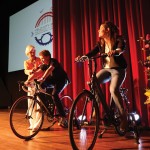
Each year, AAIC brings together this community to share study results, theories, and discoveries, with the goal of “bringing the globe closer to methods of treatment, prevention, and, ultimately, a cure for Alzheimer’s disease,” according to the association’s website.
CHALLENGES
As the premier conference in Alzheimer’s research, AAIC looks to attract participants from all over the globe, so the location of the meeting is always a big concern. This year’s high turnout — up from about 4,300 in 2012 — was due to AAIC’s location, according to Darren Mendola, the Alzheimer’s Association’s senior director of conference services. “Boston is a very international city,” Mendola said. “There’s a lot of universities around there, a lot of researchers. And it’s within a couple hours’ drive from Philadelphia, New York. We think that it helped us dramatically.”
Some years, meeting attendance is affected by recent research developments or “late game changers, where [someone] is close to announcing a product,” Mendola said. But those breakthroughs are not something that show organizers can count on. “It’s pretty rare that we have anything close to a diagnostic tool or a new drug — something in really late-stage trials — embodied in one piece of science,” said Niles Franz, the association’s senior associate director of public relations. “So we try to make sure that we have the state of the art in the whole field — whether it’s more obscure cellular-level basic science, or practical clinical tools.”
INITIATIVES
The on-site Community Research Forum, free and open to the public, was one of AAIC 2013’s big hits, drawing more than a thousand people — many of them with family members suffering from dementia. “There were also many people in the audience who were affected by the disease themselves,” Mendola said. “So we felt that it was a great success.”
To minimize the amount of printed material at AAIC, the Alzheimer’s Association made more of the meeting’s information available in its mobile app. “This year, the decision that we made was that we had everyone go through the app with their abstracts,” Mendola said, “[because] that’s the main thing for these attendees.”
A focus on participant fitness included healthier food options and morning yoga sessions, which were better planned and better attended than in 2012, Mendola said. And a group “fun run” along the shore of Boston’s Castle Island culminated in a “fun swim” when a number of attendees jumped into Boston Harbor.
Seeking to increase interaction between Alzheimer’s researchers and government entities that can help advance research in the area, AAIC convened three sessions on public policy, one of which was focused on the federal National Alzheimer’s Plan. “We’re looking at making [public-policy sessions] a different track altogether,” Mendola said. “We’re dipping our toe into the lake right now, and it worked out great.”
Convene’s Pre-Con/Post-Con series asks meeting planners about their challenges and how they intend to address them (Pre-Con), and then circles back around after the meeting has occurred (Post-Con) to see how well they worked out.



